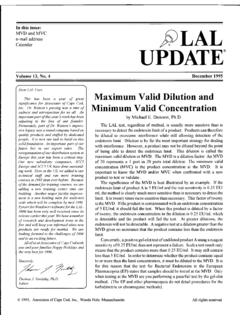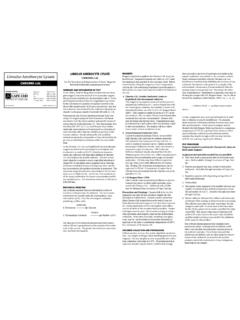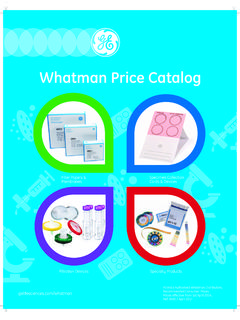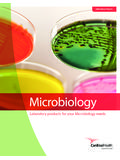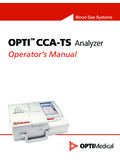Transcription of Pyrochrome Limulus Amebocyte Lysate
1 Pyrochrome for the Detection and Quantification of Gram Negative Bacterial Endotoxins (Lipopolysaccharides)The Limulus Amebocyte Lysate (LAL) test, when used according to Food and Drug Administration (FDA) guidelines (1), may be substituted for the Pharmacopeia (USP) Pyrogen Test (rabbit fever test) for the end-product testing of human injectable drugs (including biological products), animal injectable drugs, and medical devices. The LAL test is recommended for the quantitation of endotoxin in raw materials used in production, including water, and for in-process monitoring of endotoxin levels. The USP Bacterial Endotoxins Test (2) is the official LAL test referenced in specific USP monographs and is harmonized with equivalent chapters in European Pharmacopoeia (EP) (3) and the Japanese Pharmacopoeia ( JP) (4).Summary of TestLimulus Amebocyte Lysate is an aqueous extract of blood cells (amebocytes) from the horseshoe crab Limulus polyphemus.
2 In the presence of endotoxin, factors in LAL are activated in a proteolytic cascade that results in the cleavage of a colorless artificial peptide substrate present in Pyrochrome LAL. Proteolytic cleavage of the substrate liberates para-nitroaniline (pNA), which is yellow and absorbs at 405 nm. The test is performed by adding a volume of Pyrochrome to a volume of specimen and incubating the reaction mixture at 37 C. The greater the endotoxin concentration in the specimen, the faster pNA will be produced. Pyrochrome can be used to quantify endotoxin concentration in two ways (5). In the kinetic method, the time taken to reach a particular absorbance at 405 nm (the onset time) is determined. Higher endotoxin concentrations give shorter onset times. The assay requires specialized instrumentation to incubate multiple samples at a controlled temperature (usually 37 C) and to take optical density readings at regular intervals.
3 Standard curves may be constructed by plotting the log onset time against the log concentration of standard endotoxin and are used to calculate endotoxin concentrations in specimens. Alternatively, in the endpoint chromogenic method, the amount of pNA released can be measured following a fixed incubation period. A standard curve, consisting of measured optical density plotted against known standard endotoxin concentration, is used to determine concentrations in specimens. For samples that absorb at 405-410 nm, a diazo-coupling modification may be used. In this method, pNA (formed during the endpoint chromogenic method) is reacted with nitrite in HCl and then with N-(1-Naphthyl)-ethylenediamine (NEDA) to form a diazotized magenta derivative that absorbs at a range between 540-550 test methods are rapid, specific, easy to perform, and highly sensitive.
4 The detection limit depends on the method and instrumentation used and may be as sensitive as Endotoxin Units (EU) per mL. History and Biologic PrincipleHowell described the clotting of Limulus blood in 1885 (6). In the 1950 s, at the Marine Biological Laboratory, Woods Hole, MA, Bang discovered that gram negative bacteria cause Limulus blood to clot (7). Levin and Bang later determined that the reaction is enzymatic and that the enzymes are located in granules in the amebocytes (8, 9). They showed that clotting is initiated by a unique structural component of the bacterial cell wall called endotoxin or lipopolysaccharide (10). Current understanding is that the reaction consists of a cascade of enzyme activation steps terminating in the cleavage of the protein, coagulogen. The insoluble cleavage product of coagulogen (coagulin) coalesces by ionic interaction. If sufficient coagulin forms, turbidity appears followed by the formation of a gel-clot.
5 This interaction forms the basis of an assay for endotoxin termed the Limulus Amebocyte Lysate (LAL) test. In 1977, Japanese investigators discovered that endotoxin-activated LAL would also cleave small chromogenic peptides which contained an amino acid cleavage site similar to coagulogen and the chromophore, paranitroanilide (11). Cleavage results in the release of pNA, which is yellow and absorbs light at 405 nm. In this chromogenic adaptation of the LAL assay, coagulogen concentration is reduced by dilution to minimize interference when chromogenic substrate is added to the LAL. Thus, when endotoxin is added to chromogenic LAL reagent, a color is formed in preference to turbidity or a gel-clot. In all versions of the LAL assay (gel-clot, turbidimetric, and chromogenic), the greater the amount of endotoxin present, the faster the endpoint (gel-clot, turbidity, or color) develops.
6 More information about the LAL assay types, reaction, and applications is available in the literature (12, 13, 14).Reagent Pyrochrome is packaged at mL/vial in lyophilized form. It contains an aqueous extract of amebocytes of Limulus polyphemus, stabilizer, salts, buffer and chromogenic is not labeled with a specific sensitivity. Sensitivity in a given test (designated ) is the lowest endotoxin concentration used to construct the standard curve. The greatest sensitivity, , of Pyrochrome is EU/mL in a kinetic assay and EU/mL in an endpoint assay. Pyrochrome is for in-vitro diagnostic purposes only. It is not intended for the diagnosis of endotoxemia in humans. The toxicity of Pyrochrome has not been determined. However, prolonged or repeated contact of LAL with the skin has resulted in a Type I allergic reaction in some individuals (15).
7 Thus, caution should be exercised when handling Pyrochrome .Reconstitution Procedure:1. Gently tap the vial of Pyrochrome to cause loose material to fall to the bottom. Break the vacuum by lifting the gray stopper. Do not contaminate the mouth of the vial. Remove and discard the stopper; do not inject through or reuse the stopper. A small amount of LAL powder remaining on the stopper will not affect the Reconstitute Pyrochrome with mL Pyrochrome Buffer or Glucashield buffer (available separately from Associates of Cape Cod, Inc.). To obtain a sensitivity of EU/mL in a microplate reader, it is necessary to reconstitute Pyrochrome with Glucashield . This sensitivity can be attained with either Pyrochrome reconstitution buffer or Glucashield buffer in a tube reader. The pellet will take a few minutes to go into solution, therefore, rehydrate at least 5 minutes prior to use.
8 Swirl vial to insure homogeneity but avoid vigorous mixing that may cause excessive foaming and a loss of sensitivity. Cover the vial with Parafilm M and store cold (2-8 C) when not in use. Pyrochrome must be used within 8 hours of ConditionsLyophilized Pyrochrome is relatively stable and, if stored properly, will retain full activity through the expiration date on the label. Store the product at 2-8 C. Temperatures in excess of 37 C can cause rapid deterioration of lyophilized Pyrochrome as evidenced by loss of sensitivity and a distinct yellowing of the product. Pyrochrome is shipped in insulated containers to protect against high temperatures. Pyrochrome , prior to reconstitution, is light sensitive and should be stored in the Pyrochrome is usually clear and slightly opalescent. An occasional lot will exhibit a slight, uniform turbidity.
9 The presence of small fibers or strands does not indicate contamination nor affect activity; however, flocculent precipitation or a distinct yellow color indicates deterioration and the reagent should not be used. Reconstituted Pyrochrome is less stable than the lyophilized product; vials may be held for up to 8 hours at 2-8 C. Note that it may be necessary to use freshly reconstituted reagent to obtain maximum sensitivity. Reconstituted Pyrochrome cannot be Collection and PreparationSpecimens should be collected aseptically in containers that are free of detectable endotoxin. Reused, depyrogenated glassware or sterile, disposable, polystyrene or polyethylene terephthalate (PET) plastics are recommended to minimize adsorption of endotoxin to container surfaces. Not all plastic containers are free of detectable endotoxin. In addition, extractable substances from some plastics may interfere with the test.
10 Labware should be tested for acceptability by randomly selecting containers from a batch, rinsing them with a small volume of LAL Reagent Water (LRW ) at room temperature for one hour, and testing the rinse as a specimen. The rinse should contain significantly less endotoxin than the lowest standard concentration to be used. Also, the rinse should neither inhibit nor enhance the test as determined by recovery of a known amount of added endotoxin. The pH of the reaction mixture (a volume of specimen or specimen dilution mixed with an equal volume of Pyrochrome ) should be 6 to 8. Adjust the pH of the specimen with HCl, NaOH, or buffer (free of detectable endotoxin). Dilute concentrated HCl or NaOH with LRW to an appropriate concentration and use a volume that will not lead to significant dilution of the test specimen. If a precipitate forms in the sample upon pH adjustment, dilute the sample (not to exceed the MVD see Limitations of Procedure ) before adjusting the pH.





